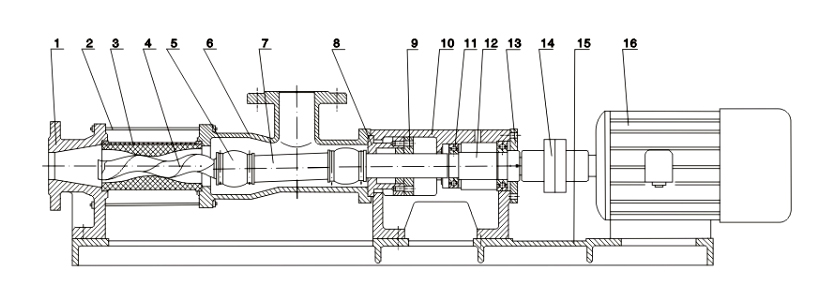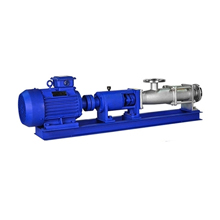How Does a Screw Pump Work?
Screw pumps, also known as single-screw or progressive cavity pumps, function based on a straightforward yet ingenious principle. At their core, they rely on the interaction between a helical rotor (the screw) and a stator (the stationary element) to move liquids from the inlet to the outlet.
Working Principle
A screw pump is a type of positive displacement pump that operates based on the intermeshing of a screw and a liner, creating changes in volume within the suction and discharge chambers to transport liquids. It is an internally engaged, sealed screw pump.
The primary components of a screw pump consist of a liner (stator) with a double-headed helical cavity and a single-headed eccentric screw (rotor) that engages with the stator cavity. When the input shaft drives the rotor to perform a planetary rotation around the center of the stator, due to the unique geometrical shapes of the rotor and stator, several separate sealing chambers are formed. The rotation of the rotor continuously, uniformly, and without changes in volume transports the medium from the suction end to the discharge end within each sealing chamber.

| 1. outlet | 2. pull bar | 3. stator | 4. screw shaft |
| 5. gimbal | 6. inlet | 7. connect shaft | 8. stuff seat |
| 9. stuff gland | 10. bearing house | 11. bearing | 12. gearing shaft |
| 13. bearing cover | 14. coupling | 15. base plate | 16. motor |
This type of pump relies on the rotation of a single screw to push the liquid forward, but its high-pressure and low-pressure chambers are not interconnected. The special design of the screw and a liner with internal helical surfaces (made of elastic material) work together to separate the liquid along the axial direction while splitting the fluid radially into two, forming individual sealed chambers. In each screw-liner pair, the screw has a single helical surface, while the inner surface of the liner has double helical surfaces, both rotating in the same direction, either clockwise or counterclockwise.
Screw pumps are suitable for applications where the medium needs to flow uniformly along the axial direction, ensuring stable pressure without generating turbulence or agitation. They are especially well-suited for transporting high-viscosity fluids, those containing solid particles, or high-fiber materials that require continuous and stable pressure.
A screw pump operates by using the rotation of a screw to draw in and discharge liquids. Due to the intermeshing of the screws and their tight fit with the inner wall of the casing, one or more sealed spaces are created between the pump's inlet and outlet.
As the screw rotates and engages, these sealed spaces continually form at the inlet of the pump, trapping the liquid from the inlet chamber and continuously pushing it along the screw's axis to the discharge end. The liquid enclosed in each space is continuously discharged, similar to how a nut is steadily advanced along a threaded rod when it rotates – this is the fundamental working principle of a screw pump. To draw an analogy, when we continuously stir a large tank of water, it creates a vortex and generates pressure, separating substances – the same principle applies.

Work Process
- Suction Phase: When the pump is initiated, the screw rotor rotates within the stator. As the screw rotates, it forms a progressing seal line between the screw's surface and the stator wall, creating a sealed cavity near the pump inlet.
- Liquid Intake: As the screw rotor continues to rotate, the sealed cavity moves axially along the stator, effectively trapping and drawing in the liquid from the inlet due to the progressive seal formed between the screw and stator.
- Transport: The sealed liquid within the cavity is then conveyed towards the discharge end of the pump as the screw rotor rotates. The rotation of the screw creates a continuous, uniform, and controlled movement of the liquid along the axial direction of the pump.
- Discharge: At the discharge end, the liquid is expelled from the sealed cavity into the outlet. The rotation of the screw rotor ensures that the liquid is delivered evenly and without pulsations, making it suitable for applications requiring a steady flow.
In essence, a screw pump works by using the rotation of a single screw to create and move sealed chambers that draw in, transport, and discharge liquids efficiently. It is an effective method for pumping viscous or abrasive fluids while maintaining a consistent and reliable flow. ATO store offers high-quality screw pumps – shop with confidence!
Safety Guidelines
- It is strictly prohibited to run the screw pump without liquid in the pump chamber. Before starting the screw pump, liquid must be injected into the pump body through the inlet to prevent dry running, which can lead to wear and damage to the screw pump stator.
- Prior to starting the screw pump, it is essential to ensure the direction of rotation is correct. The screw pump should not be operated in reverse.
- For newly installed or screw pumps that have been idle for an extended period, do not start them immediately. Instead, inject an appropriate amount of lubricant or the liquid to be pumped into the pump body. After manually turning the screw pump a few times using a wrench, you may proceed to start it.
- After transporting highly viscous fluids or corrosive media using a stainless steel screw pump, it is advisable to flush the pump chamber with clean water or a solvent to prevent blockages and potential damage to the stator during the next start-up.
- During the winter months, if a screw pump is not in use and the temperature is low, it is important to drain the pump chamber to prevent freezing or the formation of ice, which could damage the stator during the next start-up.
- Regularly lubricate the bearings in the bearing housing during operation. If you observe oil leakage at the shaft end, address it promptly, and consider replacing the seal.
- In case of any abnormal situations during operation, immediately stop the pump, investigate the cause, and rectify the issue.
Screw pumps operate on a simple yet effective principle, relying on the interaction between a helical rotor and a stator to transport fluids. Their ability to handle various materials, provide a steady flow, and minimize pulsations makes them invaluable in industries ranging from wastewater treatment to oil and gas production. Understanding the working principle of screw pumps underscores their importance and versatility in fluid handling applications.

